A takeoff technique that has almost been patented by ravens.
Four days ago I photographed a raven behavior that I’ve seen many times but never been able to document well with photos because I haven’t been able to keep the bird in the frame, and sharp, for that many sequential shots (thanks Canon R5). The behavior involves skipping from one perch to another at the beginning of takeoff, pushing off from both of them with their feet and legs in order to get a little extra acceleration and speed during takeoff.
It’s a pretty nifty maneuver that I call it a “skip-launch”.
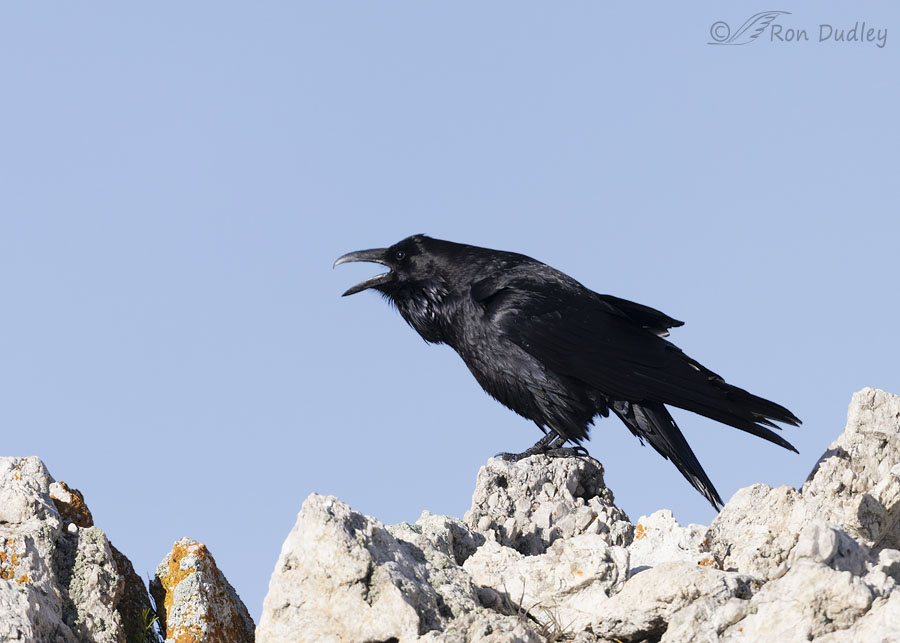
Four days ago on Antelope Island this raven was calling repeatedly from ‘his’ rocky perch. Since ravens often take off in the midst of calling, I fired off a short burst each time he opened his bill but he faked me out more than a dozen times before he actually took off. I have many photos that look almost exactly like this one.
Finally, this time he actually launched. Here his wings are just starting to open at the beginning of takeoff.
The following seven photos are sequential without any skips. The entire process took less than 7 tenths of a second.
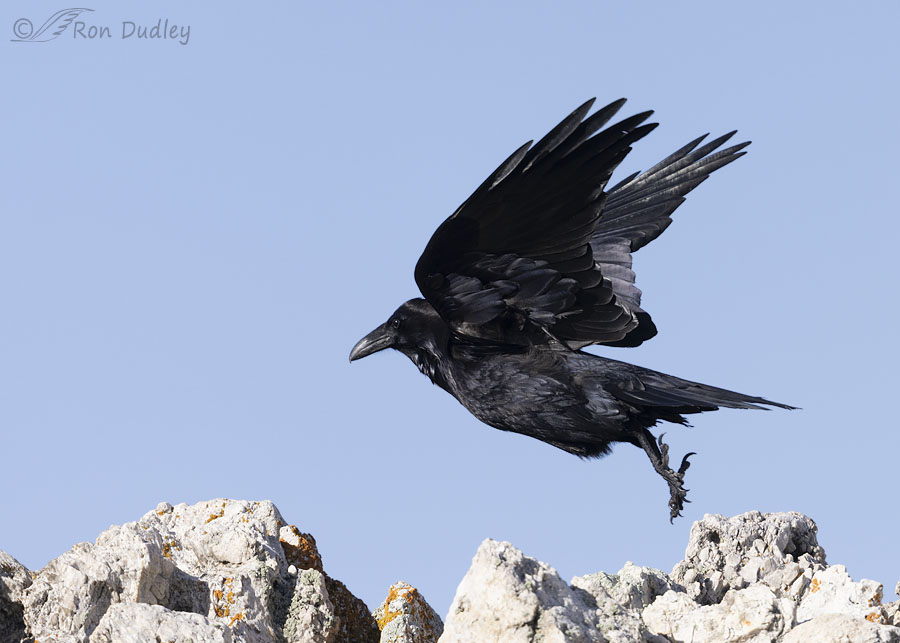
So far his takeoff is pretty traditional. As with most birds during takeoff, he pushed off with his legs and feet to increase acceleration to help get him airborne.
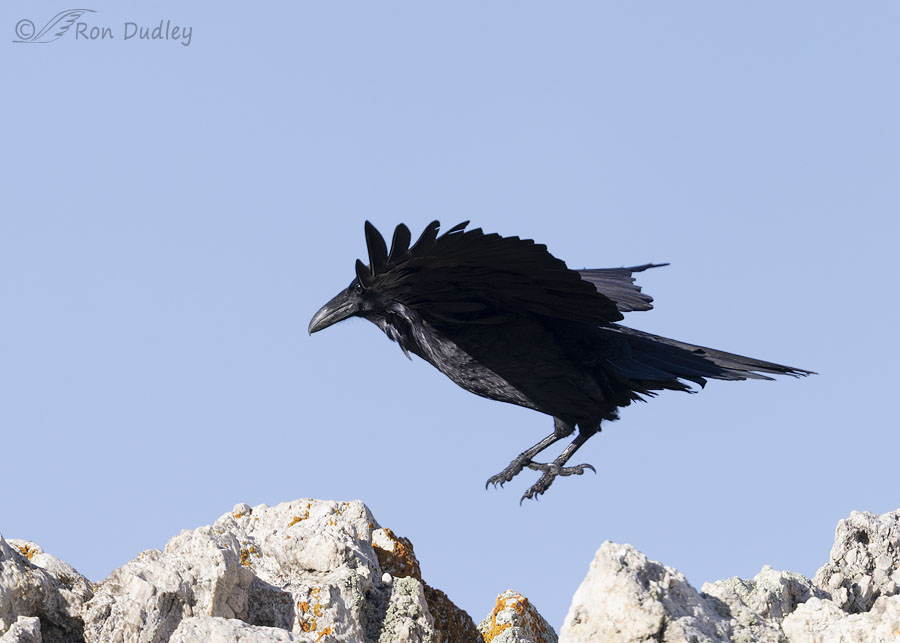
Here I already see a subtle departure from typical takeoff posture, mostly involving his legs and feet. He’s beginning to bring his feet forward in order to…
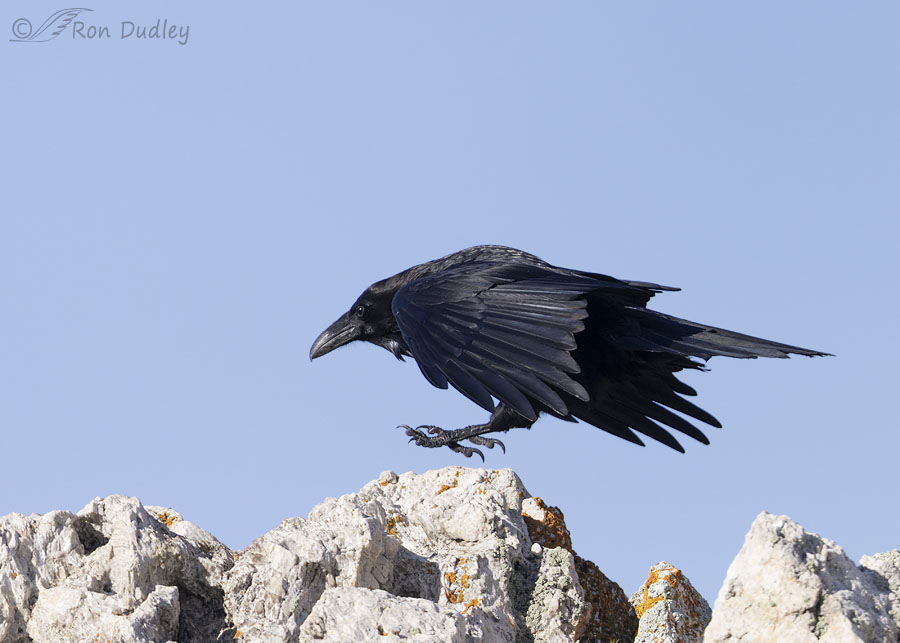
use the next rocky projection in front of him as a…
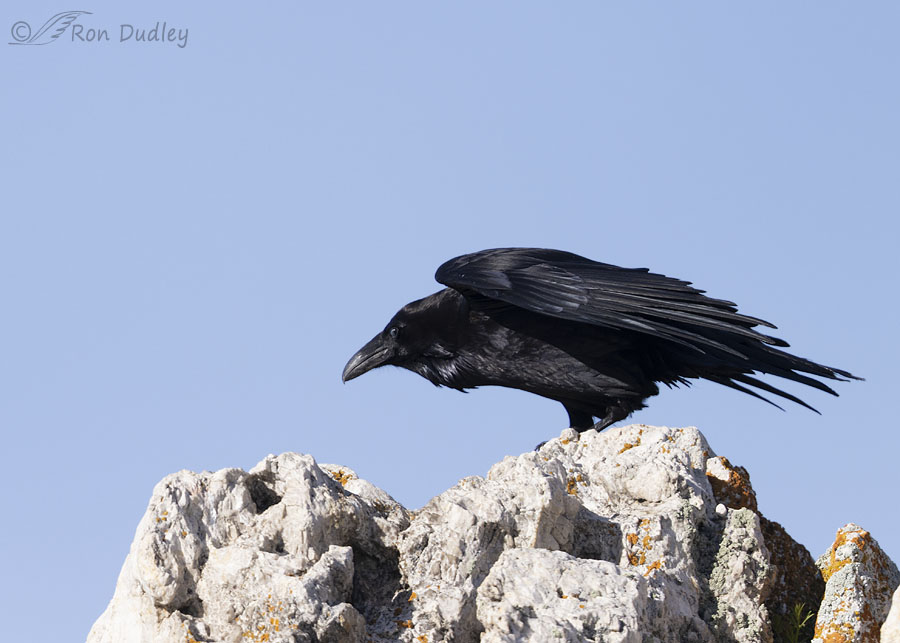
“touch and go” launching pad. When this photo was taken he hadn’t slowed down one bit. He was still moving forward at speed, which allowed him to…
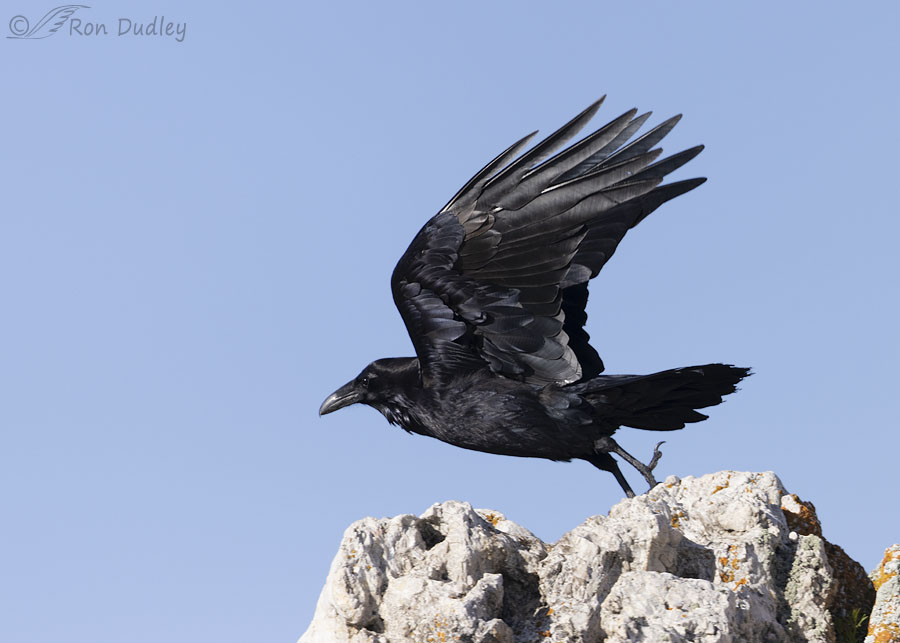
increase his acceleration and speed again as he pushed off with his feet and legs a second time during the takeoff process.
So during this “skip-launch” he was able to push off with his legs and feet twice, using them as an accessory to his wings to increase his acceleration and speed. Almost like a fighter jet using its afterburner during takeoff from an aircraft carrier. Well, sort of.
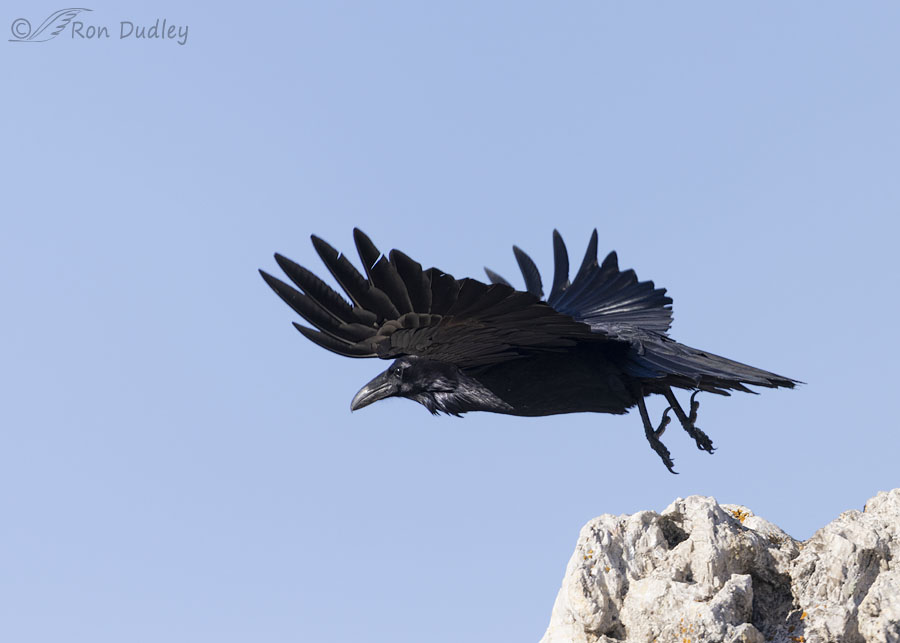
Now he’s airborne and…
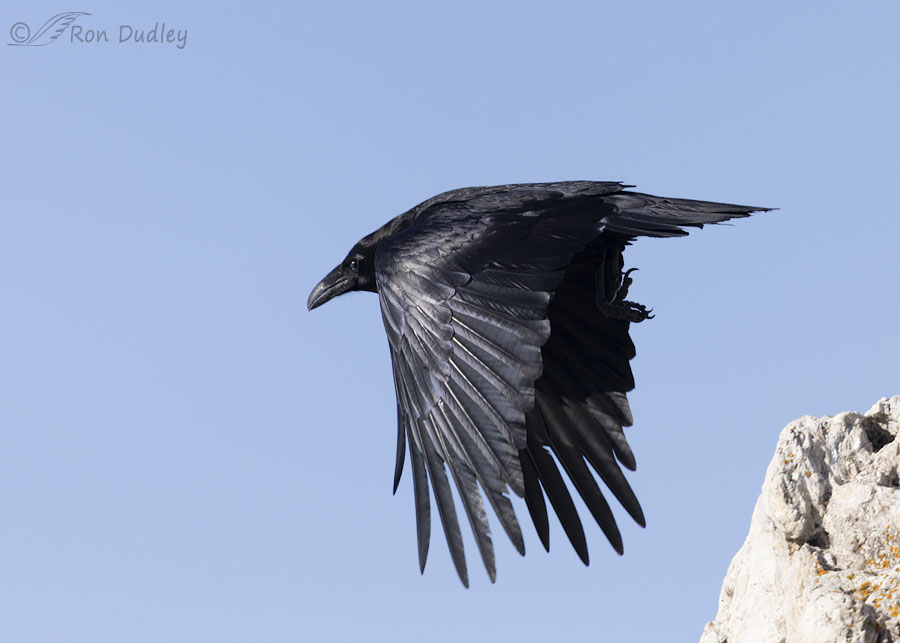
on his way, with a little more initial speed that he wouldn’t have had without the skip-launch.
Ravens use this technique fairly often. Other birds are capable of it too but I rarely see birds other than ravens actually doing it, except for other corvids, occasionally but far less often than ravens.
I’m curious, do readers of Feathered Photography, from your experience in the field with ravens and other birds, agree with my observation?
Ron


I adore ravens and will have to pay close attention to ours and see if they replicate this behaviour. I hope so, and wouldn’t be at all surprised.
Another wonderful series. Thanks Ron.
Glad you enjoyed it. Thank you, EC.
I love the colors you picked up on the ravens feathers also. I have watched crows, ravens and magpies. Would you consider the hop flutter jumps California gull do as similar?
Thanks, April. Similar maybe, but I’ve never noticed gulls taking off quite like this. But just because I’ve never noticed it doesn’t mean it doesn’t happen.
yep, that word “never” sticks in my craw when it comes to wildlife behavior. Biologists underestimate and are often surprised when they make a new observation.
Interesting observation. I can’t think of any other land bird that does this routinely. When cormorants take off from the water they push against the water 3-4 times or more with both feet before becoming airborne. They are heavy-bodied and don’t take to the air easily. Coots skitter across the water with alternate feet movements like running. Many birds hop from perch to perch but not as a way of taking flight. Something new for me to be aware of now when watching birds.
” I can’t think of any other land bird that does this routinely.”
Dan, I have a bird-knowledgeable friend who said this – “Great Horned Owls do this a lot, too. I don’t have a clue why…both species have quite light wing-loads.”
I’ve never noticed it in GHOW’s but then I don’t see them take off very often.
I seldom see Great Horned Owls take off where they can go from perch to perch. They are either perched or already in the air by the time I’m aware of them. But I also don’t spend much time out observing birds when these owls are most active. I have seen them take flight from a powerline pole in the open where there is no opportunity to go to a second perch.
This is really interesting! I did the Cornell Lab course on Crows (Kevin McGowan), and there’s another blog which follows neighborhood crows and ravens, and I don’t think either one of those mention this. Do they do this if they are on flat ground as well, or just from elevated perches?
I always learn something new from you – thank you!
“Do they do this if they are on flat ground as well, or just from elevated perches?”
Yes, they’ll do it on flat ground too Carolyn. They don’t always do it of course but they do it often enough for it to be a recognizable, if incosistent, pattern with them.
I have to admit to never watching that behavior. The Common Raven is so common here that I rarely pay much attention to them. Beautiful birds that I have a love hate relationship with. I have watched them kill one of our eagle chicks a few years back, and also have watched a pair go from nest to nest in one of our riparian woods grabbing the new chicks and they flying over to a large branch to stop and eat them. Of course it is just nature as nature is, but not fun to watch. Nice shots and excellent series. It is always hard to get a pronounced catch-eye with Ravens in that dark black head unless they just happen to turn into the light.
We have a Raven’s nest on a high utility tower near our house. I have watched them several times where one is on the nest and the other flies in and replaces that one in a flawless exchange of duties.
Everett, I envy your raven’s nest. The two raven nests I’ve had access to around here haven’t been used for several years. One of them was on a utility pole and the utility company removes nests from poles (taking care not to remove them during nesting season).
Yellowstone’s ravens do this, too. Knowing raven audacity, I always feel that they do it because they can (like breakdancers and Parkour athletes). Sorry, no science for explanation, but now I will be watching without the lame-sauce anthropomorphisms.
I loved your “lame-sauce anthropomorphism”, Suzanne. Who knows, maybe it isn’t so lame.
Great behavior capture. Like Michael I’ve noticed Ravens doing a bit of a hop on take-off but was unaware of their need for the extra “boost” Thanks, Ron, (and you too, Canon R5).
Thanks, Brett. Without the R5 I’d have been far less likely to get this many sharp shots as the raven took off. When the R5 is a good boy it’s a very good boy. When it isn’t it’s a real stinker.
You’ve gotten photos of ducks running along the surface of water as they take off. I would count that as being pretty close to the takeoff strategy of ravens that you describe.
Phil, I agree that the two techniques have some similarities.
Interesting! Wonder if they land the same way? Maybe body mass requiring more forward speed to get “lift off” ?
“Wonder if they land the same way?”
Not that I’ve noticed Judy. But then I don’t notice everything…
That’s a really interesting technique……I’m wondering now why
ravens in particular have developed it, and why other corvids also
occasionally use it ? Could it have something to do with their
body mass as compared with other, lighter birds ? Ravens in particular have such proportionately large, heavy-looking heads and necks. Might they require an extra “push” to overcome that “upfront” weight to become airborne ?
“I’m wondering now why ravens in particular have developed it.”
That’s a good question, Kris. Wish I knew.
May have seen it in my neighborhood where we have Ravens around here all the time, but just did not make note of it. Ravens so often do some kind of hop, skip and jump when on the ground that I may have not associated it as part of an assisted takeoff. Will be looking for it now.
“Will be looking for it now.”
Good. Let me know if at some point you reach any conclusions.